Forty -4 cities across the country!See what the situation in Changchun
Author:Jilin Daily Time:2022.08.01
How long does it take for you to commute daily? On July 29, the China Urban Planning and Design Institute issued the "2022 Monitoring Report of China's Major Cities in China". Compared with last year, the proportion of "extreme commuting" with one -way one -way one -way in 32 cities increased.
The proportion of "happiness and commuting" within 5 kilometers has declined across the board
Zhengzhou, Xuzhou, and Urumqi have decreased the largest
The proportion of commuting in 5 kilometers is the proportion of the nearest residence and can slowly commute, also known as "happy commute", which is an important measure for livability in the city.
The "Dialism Monitoring Report" shows that in 2021, the "happy commute" of commuting distance within 5 kilometers fell across the board. The general average level of the proportion of "happiness and commuting" in major cities was 51%, a decrease of 2%last year. A decrease of 1%, 49%of the major cities, 54%of large cities I, and 56%in large cities II, all decreased by 2%year -on -year.
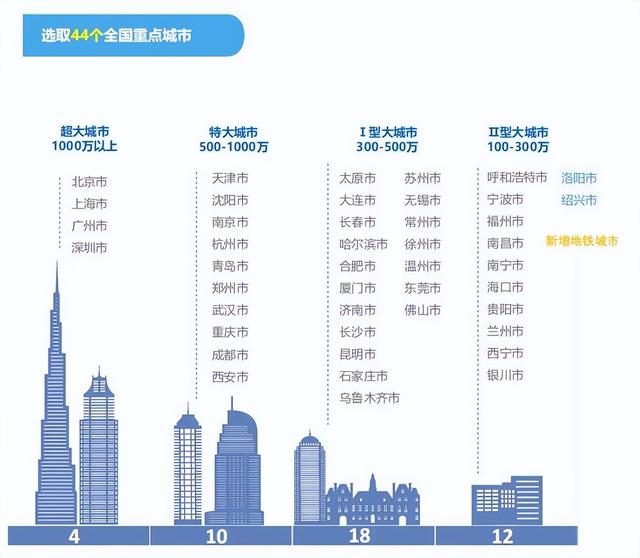
44 key cities across the country participating in the survey
The proportion of 5 kilometers of commuting in 41 cities in the 42 annual cities decreased year -on -year, and only Foshan was flat year -on -year.
The population scale of 100-3 million cities has fallen significantly. The proportion of "happiness and commuting" in 7 cities including Lanzhou, Ningbo, Hohhot, Yinchuan, Guiyang, Nanchang, and Nanning has decreased by more than 3%.
Zhengzhou, Xuzhou, and Urumqi declined the largest year -on -year, decreased by more than 4%year -on -year.
The proportion of Shenzhen happiness commutes is 58%, an increase of 1%compared to 2019, maintaining the highest level of large and large cities.
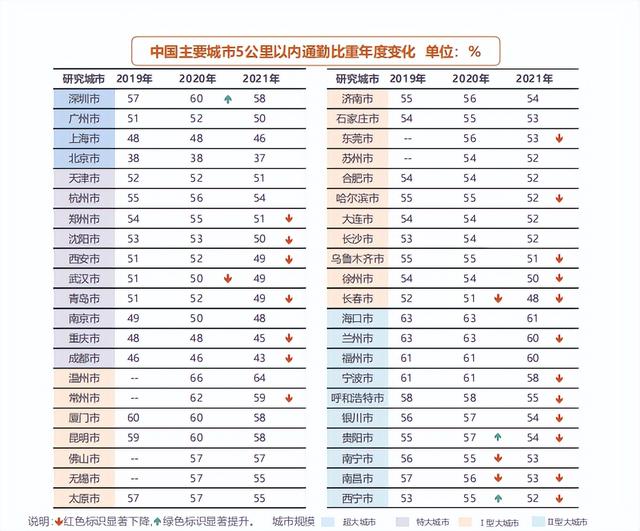
The annual change of commuting ratio within 5 kilometers in major cities changes
14 million people bear the "extreme commuting"
Beijing is the highest proportion
The commuting of more than 60 minutes of one -way time is called "extreme commuting", reducing the proportion of extreme commuting population for more than 60 minutes. Avoiding physical and mental injuries and social problems caused by long commuting is an important aspect of urban risk prevention.
The "commuting monitoring report" shows that more than 14 million of 44 major domestic cities bear the "extreme commuting", with a single -way time of more than 60 minutes of commuting, an increase of 13%, an increase of 1%year -on -year. Among them, the average level of oversized cities was 19%, an increase of 2%year -on -year, and a large city of 14%, an increase of 1%year -on -year. In the 42 annual annual comparison, the proportion of extreme commuting in 32 cities in cities has increased.
The proportion of commutes in Beijing for more than 60 minutes is 30%, which is the city with the largest number of commuting population in the country, an increase of 3%year -on -year.
Guangzhou, Qingdao, Shenyang, Tianjin, Xi'an, Changchun, Dongguan, Foshan, Jinan, Taiyuan, Nanchang and other cities have also increased by 2%year -on -year.
Only Shenzhen, Nanjing, Hangzhou, Zhengzhou, and Xiamen have decreased extreme commuting for three consecutive years.
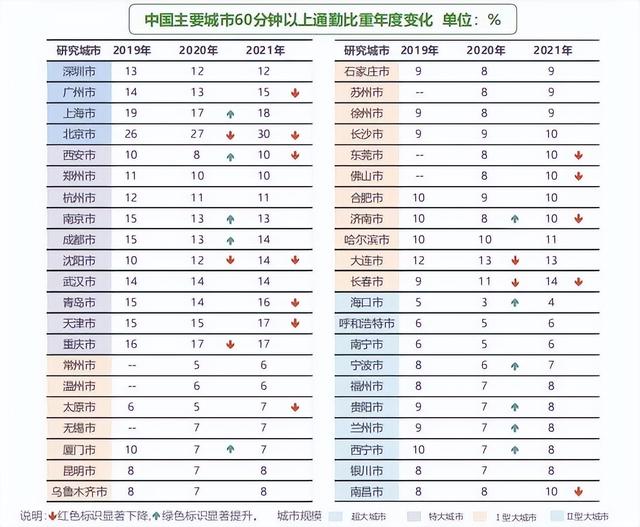
The annual changes of the year of commuting proportion of commuting more than 60 minutes in major cities
The average cities consume 36 minutes when commuting
76%of commuters can work in 45 minutes
The average consumption of commuting is an important influencing factor for residents' commute and travel intuitive feelings and quality of life, and it is an important indicator for measuring convenience of urban traffic.
The average one -way commute in 44 major domestic cities consumes 36 minutes, which is the same year -on -year. in:
The overall large cities have an average of 41 minutes, an increase of 1 minute year -on -year; 38 minutes in the large cities, 34 minutes of large cities I, and 33 minutes II cities. There is no change year -on -year.
Beijing is still the city with the longest one -way commuting, reaching 48 minutes, an increase of 1 minute year -on -year. From 2019 to 2021, Shanghai and Nanjing's commuting consume continuously, decreased by more than 2 minutes. The average one -way commuting in Shanghai was reduced from 42 minutes, and Nanjing decreased from 39 minutes to 37 minutes.

Average one -way commute time of major cities changes
Increasing the proportion of commuting within 45 minutes is an important goal of improving the urban living environment and a comprehensive manifestation of urban planning and transportation services.
The "Dialogue Monitoring Report" shows that 76%of the 44 major domestic cities can reach workplace within 45 minutes. Shenzhen's 45 -minute commute proportion is 77%and 79%of Hangzhou, which are the highest level of oversized and large cities. The proportion of commuting within 45 cities in the 42 annual cities has decreased within 45 minutes, of which 16 are concentrated in the large and large cities of TDIC.
Shenyang, Taiyuan, Dongguan, Jinan, Changchun, Haikou 6 cities decreased by 3%year -on -year.
Nanjing, Wuhan and Zhengzhou three cities increased within 45 minutes. Nanjing is the only city that has maintained growth for two consecutive years.
Guangzhou's 45 -minute commute proportion continued to decline for two consecutive years, from 75%in 2019 to 69%in 2021, a decrease of 6%.
Beijing's 45 -minute commute proportion is 55%, the lowest in major cities, a year -on -year decrease of 2%.
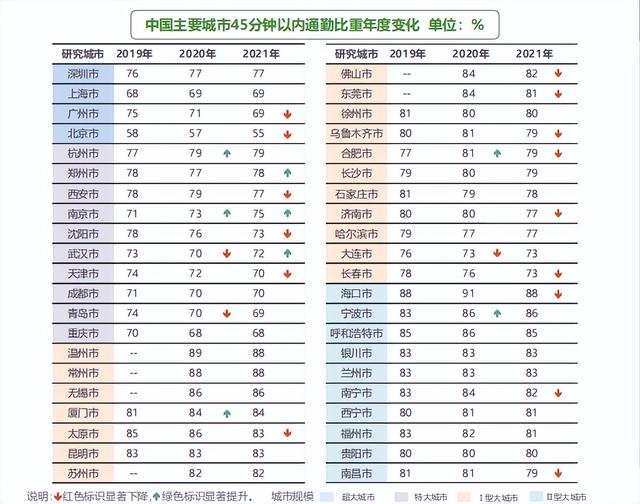
The proportion of commuting in 45 minutes changes
70%of urban vocational residence separation is increased
Xiamen Vocational Residence Balance remains the best
The separation of vocational residence can be understood as the distance from the place of residence to the recent employment venues. It is used to measure the matching and balance of the supply space supply of urban residence. The smaller the residential separation, the better the city's residential balance.
Among the 42 annual comparison cities, 31 cities and residences have increased year -on -year. The overall residence of vocational residential residence in the large cities is 4.1 kilometers, an increase of 0.2 kilometers year -on -year.
Zhengzhou's residence separation is 4.8 kilometers, an increase of 0.6 kilometers year -on -year. It is the city with the largest annual growth and the most changing job space. The separation of vocational residence in Qingdao increased from 4.5 kilometers to 4.9 kilometers, and Xuzhou increased from 4.4 kilometers to 4.8 kilometers, an increase of 0.4 kilometers year -on -year, showing the significant increase in professional residence separation. Xiamen maintains the best cities in major cities in main cities. The separation of residence is 2.2 kilometers, a year -on -year decrease of 0.1 kilometers.
Professional residence separation of major cities

The average commuting distance reflects the separation of real residence and is also the cost of urban operation, which determines the investment and traffic pressure of infrastructure.
The average commuting distance of mega cities has grown the most significantly. In the 10 cities in 10 major cities, 7 cities including Shenyang, Qingdao, Xi'an, Nanjing, Zhengzhou, Chengdu, Chongqing, etc. in 7 cities increased by more than 0.5 kilometers year -on -year.
Zhengzhou, Xuzhou, and Urumqi increased by more than 0.7 kilometers year -on -year, which is the city with the largest increase in commuting distances of the year. The average commuting distance in Beijing was 11.3 kilometers, an increase of 0.2 kilometers year -on -year. It is still the longest commute distance. The average commute distance of Shanghai, Chengdu, Chongqing, and Guangzhou exceeds 9 kilometers.
The average commuting distance of Xiamen is 7.1 kilometers, and it remains unchanged for three consecutive years. It is the only city in the main cities that has not increased year -on -year.
In 2021, the average commuting distance in major cities
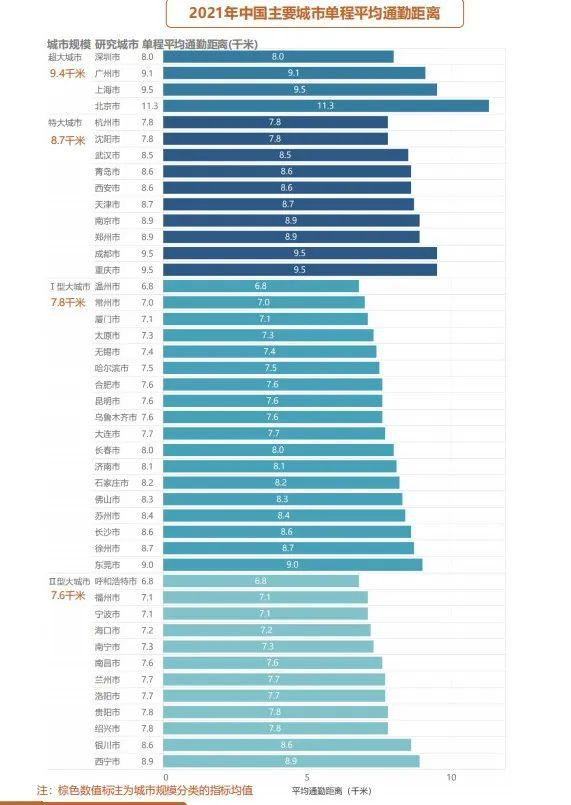
Source: China Consumer News
- END -
Entrusted new journey to build a new era · Our new era 丨 Forestry engineer Mao Ying: Let the lilac bloom gorgeous

Xinhua News Agency, Xining, June 16th: Forestry Engineer Mao Ying: Let the lilac b...
Summer public security strike "100 -day action" | Tongchuan Public Security Organ's key highlight work and summer public security strike "100 -day action" promotion meeting

You may like(Source: Tongchuan Public Security)